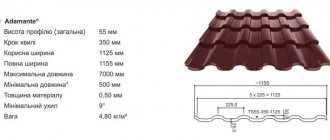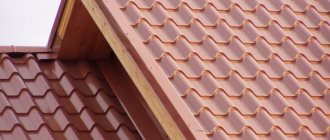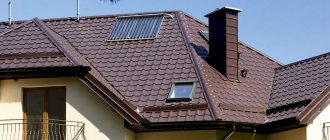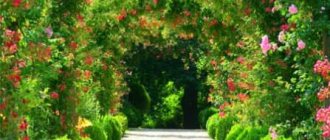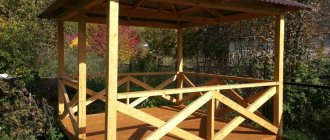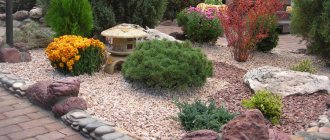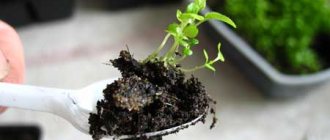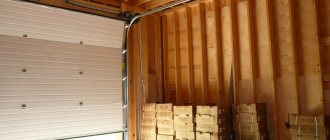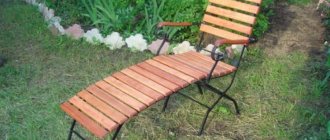Any free surface in a summer cottage can be beneficial. We have already repeatedly talked about vertical gardening and given examples of creating beds and flower beds. It's time to talk about roofs. After all, they can also be landscaped. This idea in modern landscape design began to be used not so long ago, but it is not new. History tells us about wonderful gardens that were planted in exactly the same way thousands of years ago. Babylon can be considered a trendsetter in this matter. The famous Gardens of Babylon are one of the wonders of the world. Subsequently, in Rome, Greece and Western Europe, this tradition was not only supported, but also developed. And today this method of landscaping is back in fashion.
- 2 Methods of greening a roof
2.1 Option #1 – labor-intensive and intensive method
- 2.2 Option #2 – extensive green roofs
Why is it worth doing green roofs?
Conventionally, all the advantages of this landscaping method are divided into two main categories:
- Environmental factor;
- Financial benefit.
It is difficult to overestimate the benefits of green rooftop space for the environment. Already today, some megacities cannot afford to have park areas. Air pollution with harmful gases and dust leads to numerous chronic diseases in people.
From the point of view of economic benefits, this solution significantly reduces the cost of heating a house in the summer, maintains the microclimate, and does not require extra energy costs. Premises with a special coating are more expensive, but the roofs have an advantageous long service life.
Scope of application and safety conditions
The maximum financial and environmental effect is achieved when using technology in densely populated urban areas. But in general, its use is limited only by budgetary capabilities and security requirements, including :
- Mandatory reinforcement of structures in regions with seismic impacts.
- Laying fences with a height of 1.2 m along the perimeter of buildings when people are allowed onto the roof.
- Providing reliable protection against leaks and functionality of additional systems (drainage, drainage, lighting, irrigation). When installing green roofs, the risks of gutters freezing, soil sliding over the edges of the eaves, roots breaking through membranes, or moisture accumulation in certain areas are eliminated.
Two approaches to green building
Depending on the thickness of the soil layer, intensive and extensive subtypes of landscaping on house roofs are distinguished, respectively.
The extensive type is more suitable for roof decoration. The use of a lawn, ornamental grass, flower beds, and low shrubs can reduce the effort spent on roof maintenance. The height of the soil layer ranges from 5 to 8 cm, which makes it possible to plant greenery on almost any building.
An intense look requires a well-reinforced roof and professional maintenance personnel. This subtype allows you to spread a real park right among the high-rise buildings of the metropolis. A soil thickness of more than 15 cm makes it possible to plant trees with strong roots.
DIY installation technology
The design and installation of complex intensive roofs is, without exception, entrusted to specialists, but simpler extensive types, if desired, can be installed on their own, after approval of the project.
The main attention is paid to preparing the foundation (strengthening, leveling, eliminating defects, treating with primers or primers) and laying out the correct drainage system (with the required slope and frost-free channels for water drainage).
After this, step by step:
A vapor barrier is installed with mandatory overlaps, 100% sealing of panel joints and fastening of edges.- EPS slabs are laid on top, trimmed or pre-cut at the required angle to form a slope (≈10 mm per 1 m).
- A continuous waterproofing layer is being installed. In economy versions (permissible when laying roofs on gazebos or auxiliary buildings), the use of built-up bituminous materials laid in 2-3 layers is allowed. In other cases, the waterproofing layer is formed by systems of special membranes.
- Waterproofing materials are covered with drainage membranes or felt. The filtration and separation layer is being installed with the panels being strengthened at the joints with the eaves or adjacent roof elements.
- The substrate is poured and leveled on the roof.
- The elements of the irrigation system (if any) are hidden in the soil and the plants are planted.
How to green a roof
It is not possible to create an oasis with your own hands with every type of roof landscaping. If you are determined to tackle this task yourself, first look at the photos of green roofs. It is worth making sure that the roof is well reinforced and will withstand the project you have in mind. The best solution would be to turn to professionals in this matter.
Construction begins with the formation of a screed, which is then treated with a primer. Take into account the slope for optimal drainage of water. Waterproofing materials are already applied to the cement base. The market provides a wide range of building materials of this type.
The layer provides a drain hole. Thermal insulation remains everyone's decision, in winter it can significantly save your heating costs. If you are only going to lightly decorate the roof with a lawn, there is no need to lay a root protection layer. In other cases, the roof is protected from plant roots with foil or fiberglass. The next stage of construction will be the drainage layer.
Expanded clay, pumice, and artificial polymers are traditionally chosen as materials that provide trees with moisture. You can protect drainage from contamination using geotextile fabric.
The extensive subtype of landscaping involves backfilling the soil to a depth of 5-8 cm. The soil layer should have a number of useful properties: lightness, porosity, moisture-retaining properties. Industrial soils have a number of advantages in this regard. A loose layer of gravel will prevent the soil from drying out. It is important to remember that each group of plants is suitable for a certain type of soil.
It is worth giving preference to crops that are resistant to the climate of your natural zone, dry or, conversely, excessively wet soil, increased radiation, otherwise the plant will die. Choose the highest quality materials; if the structure begins to fail, you will have to completely replace it.
Facade decoration: the top ideas for the New Year 2022How to make a frame for a craft with your own hands: step-by-step instructions with photos
Paintings for decorating a country house
If your imagination draws designs for massive park structures on the roof, the work should be entrusted to specialists. The intensive type is implemented only by professionals in their field and is not a cheap pleasure.
Device and features
The installation of such roofs involves the installation of a multi-layer exploitable pie , including:
- A strong and stable base made of reinforced concrete slabs, metal or wood.
- A vapor barrier layer that protects the cake from internal vapors and condensation. Unlike traditional blown structures, more dense and durable materials are used during its installation (reinforced or foil-coated polyethylene films, built-up bitumen or polymer sheets).
- An insulating layer made of polyurethane foam, foam glass or expanded polystyrene, designed to withstand significant weight and mechanical loads.
- A waterproofing layer made of membranes based on polymers, rubber, thermoplastic polyolefins or PVC, if necessary reinforced with reinforcement screed.
- Root protective layer made of reinforced foil, geotextile or membranes.
- Additional protective and moisture-accumulating layer made of non-woven polyester with a density of 400 kg/m3, felt, rubber. The type of drainage elements in it depends on the purpose and loads of the green roof; in most cases, this layer is formed by profiled or cellular membranes filled with granulate.
- A filtration layer made of durable panels based on synthetic fiber, which protects the remaining layers from soil penetration and external influences.
- A layer of substrate that supports plants.
If necessary, additional reinforcing, protective or separating layers are introduced into the cake design. When calculating it, the need for additional fasteners and auxiliary systems and methods of protecting them from moisture and freezing are thought out in advance.
Simplified diagram of a roof garden
Not everyone can afford to undertake a full-scale landscaping project. In the case of a simplified scheme, the presence of a fundamental structure: screed and crushed stone will be sufficient. Container plants are a successful and no less aesthetic solution. Moreover, many containers can be moved, creating amazing compositions every day.
The difficulties of creating green roofs may seem like an overwhelming burden for some. But not only you, but also the city residents will be proud of the result of your efforts. Every person needs a piece of nature, but it takes persistence to achieve this dream.
Price
The starting costs for laying the main green roof pie (without soil and plant layers) depend on the quality of the membranes in the system.
The price tag varies from 900 to 3000 rubles/m2 when using economy and middle class brands (IsoDrain, Delta Dorken, Tegola, TechnoNIKOL) and reaches 6000 or more when purchasing popular brands like Zinco.
Investments in roofing work and landscaping vary from 950 to 3000 rubles/m2. The final estimate depends on the type and number of plants planted and the need for other work (installation of automated irrigation or lighting systems, paths and fences).
